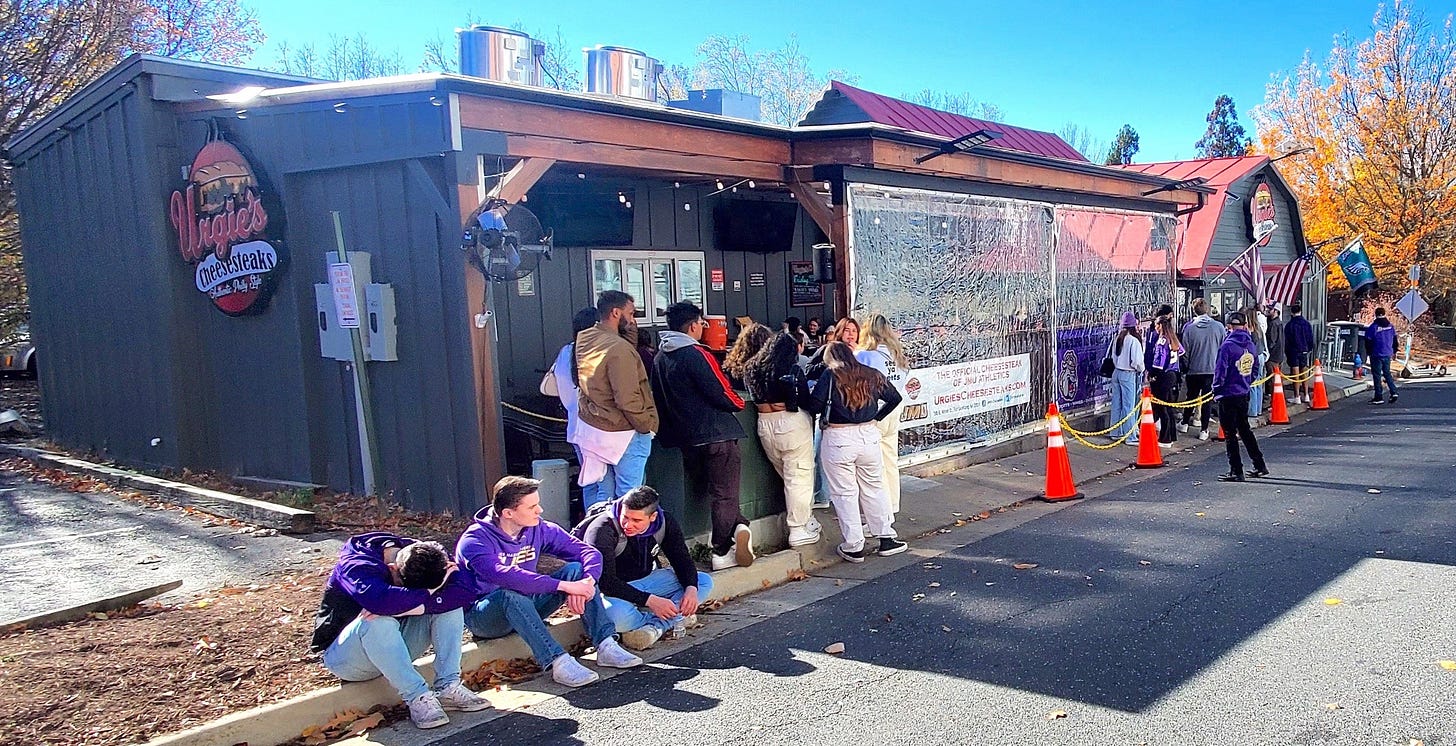From three parking spaces to neighborhood bar patio in Harrisonburg
A 2018 rezoning allowed the property to evolve in a changing neighborhood. We can make better use of land currently designated for car storage throughout the city.
The building and attached carriage house at 245 E. Water St. in downtown Harrisonburg has been a residence, an office for a drafting service, an environmental consulting business, and a media company. Property records say it was built in 1754 but I find that date dubious because those records also say the Taj of India building was built in that same year. (Local historians believe it may have originally been the detached kitchen and quarters of the enslaved for the Ott Household.)
Google Maps allows us to look back as far as 2012 to see what the building looked like over time. For most of its modern-day existence, 245 E. Water St. looked like this:
The small barn-like structure has survived several different eras of downtown. It was there long before the Urban Exchange apartments were built in the late-aughts, which brought high-density residential capacity to the block.

In 2018 the owners of a local food truck called Urgie’s Cheesesteaks bought the building and began to transform it into a Philly-themed neighborhood restaurant and bar. There were three parking spaces that backed out directly onto the street, leading to several near-misses with cars traveling east on Water Street.
The owners of Urgie’s wanted to replace the three parking spots with an outdoor dining area. In 2018, brothers Steven and Tommy Urglavitch submitted a rezoning request to remove an existing proffer that required the business to have three parking spaces. During the rezoning hearing at a city council meeting, Community Development staff explained that the parking spaces posed a safety issue for cars backing out into oncoming traffic on a narrow street. However, much of the discussion focused on concerns about where people would park if they removed the parking spaces. From the minutes:
“Council Member Hirschmann asked where they think people will park. Mr. Urglavitch stated there are plenty of parking spots downtown and they will ultimately educate their customers as to where to park … [Urglavitch] stated by removing the parking spots he feels the take-out business would decrease, however, pedestrian traffic would increase and encourage a cultural shift. He believes removing these spaces would be in the best interest of the city, the community, and downtown.”
The city council ended up voting 3-to-2 to approve the rezoning request. Deanna Reed, Richard Baugh, and Chris Jones voted in favor — Ted Byrd and George Hirschmann voted against. That rezoning allowed the property to evolve in a changing neighborhood. The Urglavitch brothers added a seated outdoor dining area and repurposed the spaces for cars into spaces for people. From the Daily News-Record in February of 2019:
Steven Urglavitch and his brother, Tommy, grew up in Philadelphia, where small neighborhood bars are a cornerstone of the community. The brothers envisioned re-creating that in Harrisonburg when they first opened Urgie’s Cheesesteaks in fall 2017.
The business has grown from its humble beginnings, from selling cheesesteaks at the Harrisonburg Farmers Market and at local breweries, to cooking under a tent, and now a brick-and-mortar restaurant and bar. Urgie’s Bar … served its first customers on Jan. 26 in the former carriage house at 245 E. Water St.

The patio has gone through several iterations. Today it is a covered outdoor dining room with picnic tables. Urgie’s has become a community gathering space for JMU and Philly sports fans in Harrisonburg. But you don’t have to be an Eagles fan to see how this is a much more productive use of the land than three temporary car storage spaces.
The parking-to-dining conversion at Urgie’s is exactly the sort of incremental improvement promoted by Strong Towns. Once the parking spaces could be used to increase customer capacity, the restaurant bar that originally started out as a food truck was able to grow its business yet again. Not only did this conversion create a new social gathering space for local sports fans and residents of the neighboring apartments, but it’s also bringing in more revenue to the city than three unmetered parking spaces.
We should work to reclaim more spaces dedicated to cars in our city and repurpose them for community gathering places like pocket parks and cafes. What if we allowed this sort of small-scale evolution to occur in certain places by-right? What if we auditioned the regularly scheduled closure of portions of Water Street on evenings or weekends during the warmer weather, as Staunton has done on Beverley Street? The pedestrianization of a few parking stalls should inspire us to ask “what if” and to experiment with reclaiming and repurposing other car-centric places in the city.









On-point thinking. Great article, Brent.